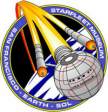 |
 |
The Development of Matter/Antimatter Drives
![]() Overview
Overview![]()
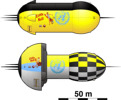 M/AM demonstrators Little Nell I & II |
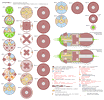 Little Nell I deck plans created by Allen Rolfes (see notes) |
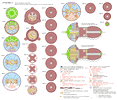 Little Nell II deck plans created by Allen Rolfes (see notes) |
![]() Scenes
Scenes
![]()
 Little Nell I created by Andrew Hall |
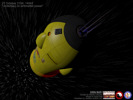 Little Nell I created by Andrew Hall |
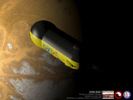 Little Nell I created by Andrew Hall |
 Little Nell II created by Andrew Hall |
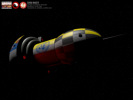 Little Nell II created by Andrew Hall |
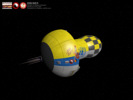 Little Nell II created by Andrew Hall |
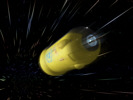 Little Nell I created by Dávid Metlesits |
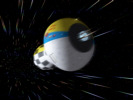 Little Nell II created by Dávid Metlesits |
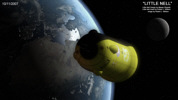 Little Nell I in Earth orbit image & mesh by Rob Willson |
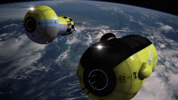 Little Nell I & II in orbit image & mesh by Rob Willson |
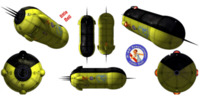 Little Nell I views image & mesh by Rob Willson |
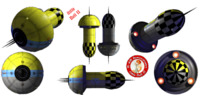 Little Nell II views image & mesh by Rob Willson |
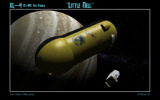 Little Nell I created by Dragonpyper |
 Little Nell II created by Dragonpyper |
 "Desktop Nell" image & mesh by Rob Willson |
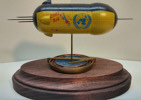 Little Nell I model model by Ugh Models |
![]() History
History ![]()
Limitations of Fusion-Powered Warp Ships
At the start of the Earth-Romulan War in 2156, all belligerent powers used warp-capable ships powered by fusion reactors. Although rarely used for this purpose today, fusion reactors were the sole means of power for the first century of warp flight on Earth. Fusion-powered warp reactors have decided disadvantages when compared with modern matter/antimatter (M/AM) systems. Probably the most serious disadvantage, in tactical terms, is their relatively low efficiency. To form and maintain a warp field, fusion reactors must consume deuterium at extremely high rates, which places two limitations on a ship's capabilities. First, a large percentage (20% or more) of the ship's internal volume is fuel, which limits non-fuel payload, such as weapons, sensors, and shuttlecraft. Second, the high rate of consumption severely limits range. The first limitation of payload can be partly addressed by scaling up the ship. Since a fixed percentage of a ship's mass must be fuel and drive system to operate at a given warp speed for a given duration, the non-fuel payload can be increased by increasing the total size of the ship. The second limitation of range must be addressed by frequently refueling at starbases, convoying the ship with tankers, or rendezvousing with tankers en route. Another disadvantage of fusion reactors is their low peak power output, which limits the maximum speed that can be achieved.
Because of these limitations of range, speed, and payload, fusion-powered ships were unsuited for offensive interstellar operations. For an attack to succeed, it must be made either when and where the enemy is least prepared or with an overwhelming superiority of force. However, the limitations of range meant that attacks across more than 10 ly of interstellar space could not be accomplished without repeated refueling, which required that ships drop out of warp and risk detection and interception. If possible attack corridors shorter than 10 ly were continuously well defended, all attacks could be probably be discouraged or repelled. Furthermore, the maximum speed of wf 2.9 meant that a journey of 10 ly would take at least 150 days, during which time detection and interception become increasingly likely. If a ship were to carry enough armaments for a powerful attack on enemy ships or ground targets, the fixed percentage of available payload meant that the ship would probably be extremely large and poorly maneuverable at both warp and impulse speeds. Fighter carriers, of course, were impractical within these payload limitations.
When United Earth (UE) forces were finally given the opportunity to go on the offensive after a Romulan invasion fleet was destroyed at the Battle of the Vela Gap in 2157, the strategies available were severely limited by the poor quality of United Earth Stellar Navy (UESN) warships. Despite broad popular support for attacks against Romulans planets, the UE and her allies simply did not have ships of sufficient capability and in sufficient number to successfully undertake offensive operations. Instead, ship-to-ship combat most often took the form of long-range missile duels. Opposing ships would cautiously venture out from their bases until long-range sensor contact was made. The ships would then usually close within extreme missile range, fire a volley of missiles, then attempt to evade their opponent's missiles. As a result, many engagements ended without significant damage to either ship. For the UE to undertake offensive operations, a power source enabling more-dynamic warp flight was obviously needed.
 |
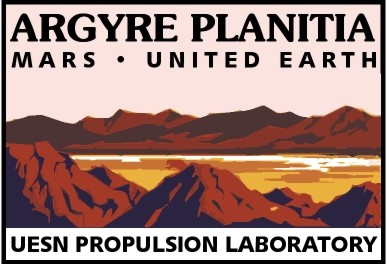 |
The First Matter/Antimatter Reactors
Although antimatter had become a popular plot device in "scientifiction" (an extinct literary genre) of the 20th century and had been produced in minute quantities by the turn of the 21st century, practical M/AM reactors were long considered no more than a dream. However, in 2139 researchers at the Vulcan Academy of Sciences and the UE Institute for High-Energy Physics at Tsukuba, Japan, jointly developed the Richardson-Tachikawa process for the mass production of antimatter. With this process, researchers could finally obtain antimatter in sufficient quantities to begin construction of Colossus, a prototype M/AM reactor, which came on-line at the UESN Propulsion Laboratory's Argyre Planitia research station in 2147. Although Colossus was successful, it weighed an estimated 250,000 tons and sprawled over some 5 hectares of Martian desert. Obviously, considerable refinement was necessary before an M/AM reactor could power a ship's warp drive. However, by 2152 a reactor (SSWR-I-A) had been constructed with a weight of 10,400 t and a volume of 8,000 m^3, just small and light enough to be mounted in a starship. On September 4, 2154, the M/AM technology demonstrator Little Nell (XL-4) was towed from Utopia Planitia UESN Yards to the Jupiter flight range, where it made Earth's first M/AM-powered warp flight.
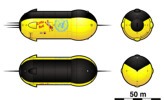 Little Nell I |
 |
|
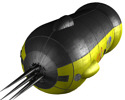 3D model created by Fabio Passaro © 3D Gladiators |
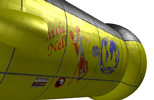 Close view created by Fabio Passaro © 3D Gladiators |
With the start of the war in February 2156, the UE War Council decided to make production of a M/AM-powered warships a priority. As a result, 50 trillion new solar dollars per year were dedicated to M/AM reactor development. This investment equalled, as a percentage of gross domestic product, that of the old United States of America for development of the first fission munitions in the mid-20th century. The flight test program was proceeding smoothly when on her 10th flight on April 23, 2156, Little Nell was destroyed by a catastrophic warp core explosion, likely due to spalling or delamination of the inner surface of the M/AM reaction chamber. However, within six months a second prototype, Little Nell II (XL-4A), was launched. Ironically, the destruction of Little Nell may have actually accelerated development, as the new SSWR-II-A reactor installed in Little Nell II incorporated numerous improvements ahead of the original development schedule as well as being lighter (7,100 tons) and smaller (5,400 m^3). After an accelerated testing program the improved SSWR-II-A reactor was formally certified by the UESN Propulsion Board for installation in naval vessels in January 2157. The first ships to use the new reactor were Krechet-class cruisers (CCM-1).
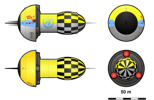 Little Nell II |
 |
|
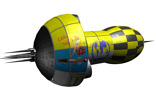 3D model created by Fabio Passaro © 3D Gladiators |
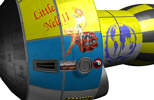 Close view created by Fabio Passaro © 3D Gladiators |
Risks of Introducing M/AM-Powered Ships
In the aftermath of the failed Romulan invasion of October 2157, a call went up throughout UE space for immediate retribution. Citizens of Earth and her colonies now believed that merely defending UE space against the Romulans was no longer sufficient; instead, they felt that Romulan worlds must be directly attacked. However, in 2157 the UESN was not yet able to mount offensive operations. As the outcome of the Romulans' attempted invasion so clearly showed, fusion-powered ships were simply too large, too slow, and had payloads and unrefueled ranges too small to successfully attack across distances of more than a few light-years. In fact, the Romulan invasion fleet had been discovered when a UESN M/AM-powered cruiser followed Romulan tankers attempting to rendezvous for refueling.
These limitations were recognized by the UESN Admiralty, who tried to explain to an increasingly outraged public that destruction of the Romulan homeworld was not a war aim of the UE-Andor alliance. The Admiralty had long believed that the mission of the UESN was to defend allied space and had prepared its fleets accordingly. Unless the Romulans were to obtain more powerful warp drives, the UESN's existing fusion-powered ships supplemented by M/AM-powered ships in limited roles were likely sufficient for defensive actions. However, if the UESN were now ordered to go on the offensive, the necessary changes in equipment, tactics, training, and crew deployment would be extremely costly yet were not guaranteed to achieve the desired affects.
The Admiralty had three main concerns about the possible fleet-wide use of M/AM reactors. First, the Admiralty did not have complete faith in the new reactors' safety and reliability. According to a classified reported prepared by the BLAND Corporation in 2155, the UESN should be prepared to accept the loss of approximately 1 of 15 ships each year through catastrophic reactor containment failure. While the actual rate of ship loss was far less than feared, the fact that an entirely new reactor system using the most unstable possible fuel had gone from theory to large-scale production in only 10 years, part of that under wartime conditions, warranted extreme caution. In addition, endurance tests suggested that under normal operating conditions, the M/AM reactor would have a lifetime of only 3 to 4 years. However, before that time, the warp nacelles would also likely need to be refurbished or replaced because of accelerated degradation of the warp coils' crystalline structure owing to the higher power output levels possible with M/AM reactors.
A second concern of the Admiralty was that the start of full-scale production of M/AM-powered starships would likely cause at least a temporary decrease in the total number of starships in service. One reason for this decrease was that shipyard facilities, materiel, and manpower would necessarily be diverted to hull conversion and the production of new hulls and reactors. Furthermore, projected losses of fusion-powered ships (based on current loss rates) would likely exceed production of new M/AM-powered ships for at least several years. Finally, and perhaps most importantly, was an anticipated shortage of engineers able to operate and maintain M/AM reactors.
Such a decrease in fleet readiness levels might not be immediately dangerous, since the Romulans were considered unlikely to launch an offensive after the huge losses of ships and crews suffered in their failed invasion. However, despite this assumption, the production capacity of the Romulan Star Empire and the size of their fleet could not be determined with any degree of certainty. In fact, very little was known about the Romulans themselves: after the Battle of the Vela Gap, the UESN Bureau of Technology Assessment sifted through what little remained of the Romulan fleet and concluded that the Romulans were "likely humanoid." Although the possibility that the Romulans would soon attempt another invasion was usually discounted, should they do so while the UESN was in a weakened state due to the transition from fusion power to M/AM power, the war might be lost.
The third concern of the Admiralty about the fleet-wide use of M/AM reactors was the availability of antimatter. As the only major use for antimatter in 2157 was as a fuel for UESN starship reactors, it was produced at high cost at a small number of facilities, all on Earth. In contrast, deuterium, although consumed in large quantities by fusion reactors to achieve warp speed, had been the chief starship fuel for more than 100 years and could easily be obtained anywhere. If antimatter was to power a fleet of starships operating across interstellar distances, a system for its manufacture, storage, and transport far from Earth would eventually need to be established. However, since all ships were fully fueled at the time of their launching, the need to refuel, although inevitable, was not anticipated for one to two years.
Despite these concerns, UESN engineers continued their work into applications of M/AM power. The first ships to enter service were those of the Krechet class in April 2157. Reactors subsequently became smaller, allowing a greater variety of ship types to exploit the new power source. New ship classes entering service in the 12 months after Krechet included Torsk-class destroyers (CEM-1), Tannhäuser-class heavy cruisers (CHM-55), Olympus Mons-class combat transports (APM-50), Farragut-class fleet monitors (FMM-1), Marconi-class subspace communications ships (ACSM-6), Powhatan-class cruisers (CEM-15), Yorktown-class carriers (CVM-5), and Minotaur-class fighters. The significantly better performance of even these early M/AM-powered vessels over conventional fusion-powered vessels convinced the Admiralty of the worth of the new reactors. The final years of the war saw the introduction of Conqueror-class heavy cruisers (CHM-69) and the first "modern" starships, the Comet-class light cruisers (CLM-102).
Advantages of M/AM-Powered Ships
The advantage that M/AM ships gave the UESN cannot be overstated. With the higher speeds and greater ranges possible, the UESN could choose when and where to engage the Romulan fleet and could attack too many targets for the Romulans to adequately protect. The sudden appearance of so many M/AM-powered ships of numerous classes and the rapid destruction of their invasion fleet at the Battle of the Vela Gap likely came as a profound shock to the Romulans. According to a Romulan Commander who defected to the Federation in 2268, several members of the Romulan Imperial Guard's High Command came to believe that the war could not be won. They recognized that the starship technology and industrial capacity of the UE far surpassed their own. Even if the Romulan Star Empire could somehow resist the expected attacks from the UE-Andor alliance and transform the conflict into a war of attrition, the superior industrial capacity and greater population of the UE would mean certain, eventual victory. These officers approached the Praetor to suggest that peace feelers be sent through Vulcan intermediaries. Although they had clearly and correctly assessed the dire situation confronting the Romulans, they were tried and executed for sedition under emergency wartime laws. The war would drag on for a further three years with the outcome never in doubt.
Such was the importance of M/AM reactors to the war effort that the UE went to great lengths to prevent the technology from falling into Romulan hands: unknown to all but the most senior UESN officers, most M/AM-reactor-powered ships carried self-destruct charges, the first ever on UE ships. Even after the war, the UE tried to prevent other powers from obtaining M/AM reactors, including Vulcan, Tellar, and wartime ally Andor. This policy naturally led to strains within the alliance, and nearly scuttled the foundation of the United Federation of Planets. However, by 2165 M/AM reactors had been installed in nearly all Starfleet vessels and in many Federation merchant vessels as well. Eventually, most spacefaring powers managed to obtain the technology, through purchase, licensing agreement, or, in many instances, through extralegal routes courtesy of the Orions. Such was the rapid dispersion of this technology that when Starfleet made official contact with the Klingons in 2218, they were only slightly surprised when analysis showed that the Klingon vessels were powered by M/AM reactors remarkably similar to the standard Federation design.
![]() Little
Nell I Specifications*
Little
Nell I Specifications*
![]()
| Overall | 1° Hull | 2° Hull | Nacelles | |
| Length [m] | 84.61 | 57.63 | - | 28.01 |
| Beam [m] | 34.27 | 34.27 | - | 32.62 |
| Draft [m] | 34.27 | 34.27 | - | 32.62 |
Standard displacement: 61,105 t
Crew complement: 66 (6 officers + 60 crew)
Embarked craft: 2 cargo/personnel shuttlecraft
Warp drive: SSWR-I-A spherical cavity M/AM reactor with 1 Kraftei VII nacelle
Velocity: wf 2.7, cruise; wf 3.1, supercruise; wf 3.2, maximum
![]() Little
Nell II Specifications*
Little
Nell II Specifications*
![]()
| Overall | 1° Hull | 2° Hull | Nacelles | |
| Length [m] | 89.55 | 29.34 | 23.01 | 37.19 |
| Beam [m] | 47.71 | 47.71 | 23.85 | 29.36 |
| Draft [m] | 47.71 | 47.71 | 23.85 | 29.36 |
Standard displacement: 58,047 t
Crew complement: 70 (8 officers + 62 crew)
Embarked craft: 2 cargo/personnel shuttlecraft
Warp drive: SSWR-II-A spherical cavity M/AM reactor with 1 Tadpole II nacelle
Velocity: wf 2.9, cruise; wf 3.3, supercruise; wf 3.4, maximum
*Dimensions do not include external comms antennae
![]()